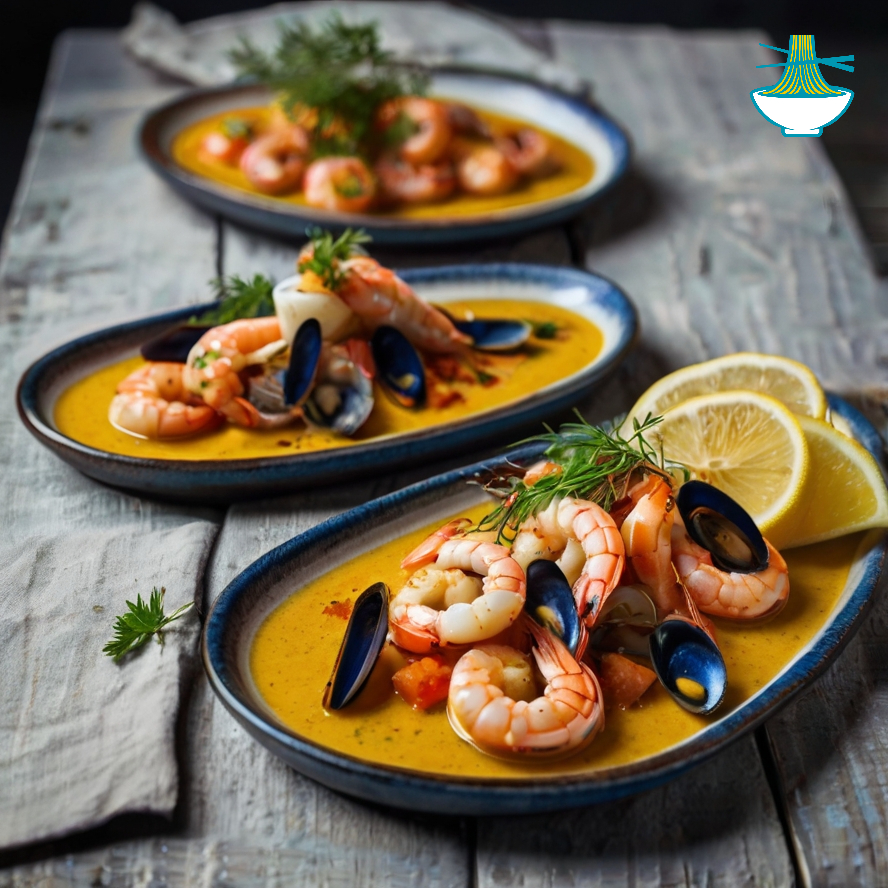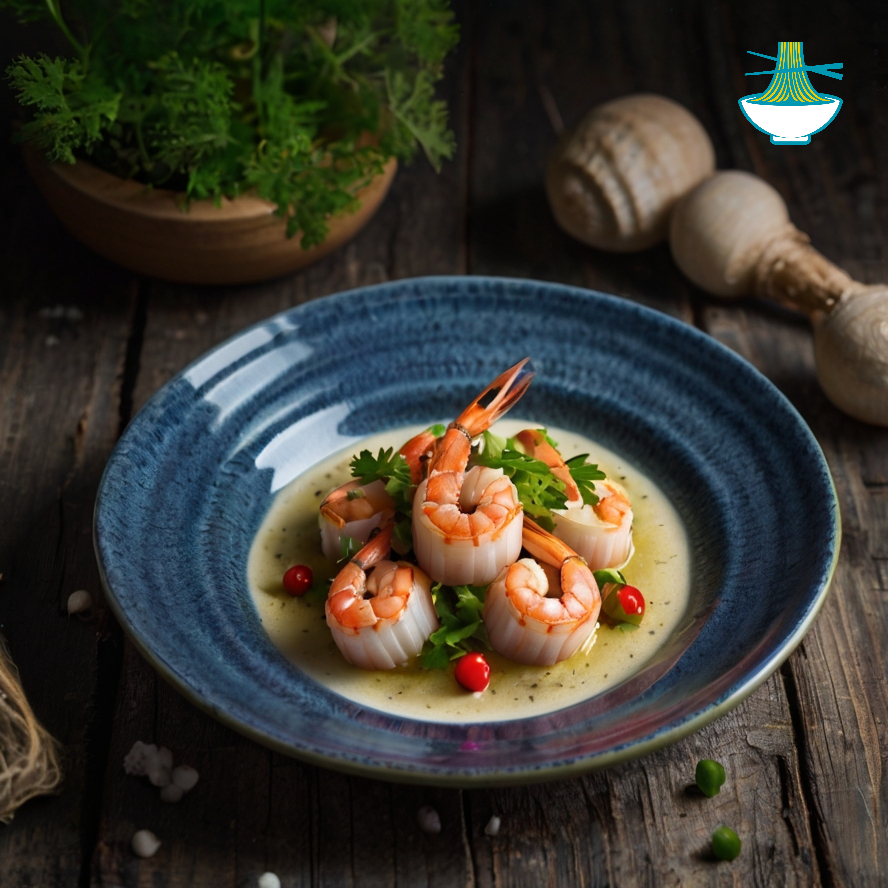Jūrinis maistas, or seafood, is an integral part of Lithuanian cuisine, owing to the country’s access to the Baltic Sea. Fresh fish, such as herring, trout, and pike, along with shellfish, are commonly featured in Lithuanian seafood dishes. These meals are typically prepared in a variety of ways, including grilling, smoking, frying, or even pickling. Seafood is known for being an excellent source of protein, omega-3 fatty acids, and essential vitamins, all of which support heart health, brain function, and overall wellness. While seafood provides significant nutritional benefits, it is important to consume it in moderation, especially when incorporating salted or smoked varieties, due to their sodium content. Jūrinis maistas not only offers a flavorful and nutritious way to enjoy the bounty of the Baltic Sea but also connects Lithuanian cuisine to its maritime traditions.
Ingredients for Lithuanian Smoked Herring (Rūkyta Silkė):
- 4 whole herring, gutted and cleaned
- 2 tablespoons salt
- 1 tablespoon sugar
- 1 teaspoon black peppercorns
- 1 tablespoon dill seeds (optional)
- Wood chips for smoking (oak or alder recommended)
Ingredients for Lithuanian Fish Soup (Žuvienė):
- 2 whole fish (pike or perch), cleaned and cut into pieces
- 2 tablespoons vegetable oil
- 1 onion, chopped
- 2 carrots, sliced
- 2 potatoes, peeled and cubed
- 1 leek, sliced
- 1 tablespoon salt
- 1 teaspoon black pepper
- 2 bay leaves
- Fresh dill for garnish
Instructions for Smoked Herring (Rūkyta Silkė):
- In a small bowl, mix together the salt, sugar, black peppercorns, and dill seeds.
- Rub the mixture onto the herring, ensuring the fish is well-coated.
- Place the herring in the refrigerator for at least 6 hours or overnight to marinate.
- Prepare your smoker according to the manufacturer's instructions and preheat it to about 180°F (82°C).
- Place the herring in the smoker and smoke for 1.5-2 hours, or until the fish is tender and fully cooked.
- Let the fish cool before serving. Serve with boiled potatoes and fresh bread for an authentic Lithuanian experience.
Instructions for Fish Soup (Žuvienė):
- Heat the vegetable oil in a large pot over medium heat. Add the chopped onion and sauté for 2-3 minutes until softened.
- Add the sliced carrots and potatoes to the pot and cook for another 5 minutes, stirring occasionally.
- Pour in 4 cups of water, and bring to a boil. Add the fish pieces, salt, pepper, and bay leaves.
- Lower the heat and let the soup simmer for about 30 minutes, or until the fish is cooked through and the vegetables are tender.
- Remove the bay leaves and discard them.
- Ladle the soup into bowls and garnish with fresh dill before serving. This dish pairs well with rustic bread.
Popular Cooking Methods in Lithuania:
Lithuanian seafood dishes are typically prepared using various cooking methods that enhance the natural flavors of the fish. Some of the most common methods include:
- Grilling: Many types of fish, including herring and trout, are grilled, often seasoned simply with salt, pepper, and herbs like dill or thyme.
- Smoking: Smoking is one of the most traditional methods for preparing fish, especially herring. This method preserves the fish and adds a rich, smoky flavor.
- Pickling: In Lithuania, pickled fish is a common delicacy, often prepared with vinegar, salt, and aromatic spices. Pickling preserves the fish and gives it a tangy flavor.
- Fish Soups: Fish soups, like Žuvienė, are a staple of Lithuanian cuisine. These are typically made with a variety of fish, root vegetables, and herbs.
Note:
Additional Fish Varieties Commonly Used in Lithuania:
- Trout: A popular freshwater fish often grilled or smoked. It is high in protein and omega-3 fatty acids, making it a heart-healthy option.
- Salmon: While not as commonly found in traditional Lithuanian dishes, salmon is gaining popularity due to its rich flavor and health benefits, particularly omega-3 content.
- Pike: Known for its firm texture, pike is often featured in fish soups, such as Žuvienė, and is also commonly fried or grilled.
- Baltic Sprat: A small, oily fish similar to sardines, often canned or smoked, which is a staple in Lithuanian kitchens.
- Mussels and Clams: While not as widely consumed, shellfish like mussels and clams are found in some coastal Lithuanian dishes and are increasingly featured in modern interpretations of Baltic cuisine.
How to Choose Fresh Fish:
When buying fresh fish, whether from a market or grocery store, here are some tips to ensure quality:
- Look at the color: Fresh fish should have a bright, clear appearance. The flesh should be firm and moist, with no discoloration.
- Check the eyes: The eyes of fresh fish should be clear and bulging, not cloudy or sunken.
- Smell: Fresh fish should smell like the ocean, not overly "fishy." If it has a strong, unpleasant odor, it's likely past its prime.
- Texture: Fresh fish should feel firm to the touch and bounce back when pressed gently.
Seafood as Part of a Balanced Diet:
- Seafood is a great source of high-quality protein, low in saturated fat, and rich in essential vitamins and minerals. Including seafood like herring, pike, or mussels in your diet can contribute to a well-rounded, heart-healthy eating plan. For those following a vegetarian or plant-based diet, seafood can be a valuable source of omega-3s and B vitamins. Adding grilled fish or shellfish to a salad or vegetable stir-fry can provide a satisfying protein boost without compromising on nutrition.
Lithuanian Seafood and Global Cuisine:
- Lithuania's seafood dishes are influenced by its geographic location along the Baltic Sea. The traditional ways of smoking, pickling, and grilling fish are common across many Northern European countries. Lithuania’s emphasis on fresh, local fish parallels practices found in Scandinavian and Polish cuisines. Additionally, modern Lithuanian chefs are exploring new ways to incorporate seafood into contemporary dishes, blending traditional Baltic methods with international culinary trends.
FAQs about Lithuanian Seafood:
1. What are the most commonly used fish in Lithuanian cuisine? Lithuanian cuisine features a variety of fish, with the most common being herring, perch, and pike. Smoked or grilled herring, in particular, is a traditional favorite.
2. What are the health benefits of eating fish in a balanced diet? Fish like herring, pike, and salmon are rich in omega-3 fatty acids, which promote heart health, reduce inflammation, and improve brain function. They also provide vitamin D, which supports bone health and immune function.
3. How can I choose fresh fish at the market? When purchasing fresh fish, look for firm flesh, clear eyes, and bright skin. Avoid fish with an overly "fishy" odor or dull, discolored flesh. Fresh fish should smell like the ocean, not off-putting.
4. Can seafood be used in vegetarian dishes? Yes, seafood can be added to vegetarian dishes for a healthy protein boost. For example, grilled fish can be served in salads or vegetable stir-fries to complement the plant-based ingredients.
5. What are some popular ways to prepare seafood in Lithuania? Lithuanians typically prepare seafood by grilling, smoking, pickling, or making fish soups. Traditional dishes like Žuvienė (fish soup) and smoked herring are widely enjoyed.

Nutritional values and benefits
4 Whole Herring (400g)
- Calories: 280
- Carbohydrates: 0g
- Protein: 40g
- Fat: 14g
- Sodium: 360mg
- Vitamins:
- Vitamin A: 250 IU (5% DV)
- Vitamin D: 1,000 IU (250% DV)
- Minerals:
- Calcium: 40mg (4% DV)
- Iron: 1.4mg (8% DV)
Nutritional Benefit: Herring is an excellent source of omega-3 fatty acids, which promote heart health and reduce inflammation. It also provides a significant amount of vitamin D, which is crucial for bone health and immune function.
2 Whole Pike or Perch (500g)
- Calories: 300
- Carbohydrates: 0g
- Protein: 60g
- Fat: 5g
- Sodium: 80mg
- Vitamins:
- Vitamin B12: 3mcg (100% DV)
- Vitamin D: 300 IU (75% DV)
- Minerals:
- Calcium: 30mg (3% DV)
- Iron: 1mg (5% DV)
Nutritional Benefit: Pike and perch are both high in protein and provide important vitamins like B12, which supports energy production and red blood cell formation. They are low in fat and provide healthy nutrients without added calories.
2 Tablespoons Vegetable Oil (30g)
- Calories: 240
- Carbohydrates: 0g
- Protein: 0g
- Fat: 28g
- Sodium: 0mg
Nutritional Benefit: Vegetable oil is rich in unsaturated fats, which support heart health and help in the absorption of fat-soluble vitamins.
1 Onion (100g)
- Calories: 40
- Carbohydrates: 9g
- Protein: 1g
- Fat: 0g
- Sodium: 4mg
- Vitamins:
- Vitamin C: 8mg (13% DV)
- Minerals:
- Calcium: 20mg (2% DV)
- Iron: 0.2mg (1% DV)
Nutritional Benefit: Onions are rich in vitamin C, which helps boost immunity, and provide fiber, which aids digestion.
2 Carrots (120g)
- Calories: 50
- Carbohydrates: 12g
- Protein: 1g
- Fat: 0g
- Sodium: 50mg
- Vitamins:
- Vitamin A: 12,000 IU (240% DV)
- Minerals:
- Calcium: 30mg (3% DV)
- Iron: 0.6mg (3% DV)
Nutritional Benefit: Carrots are packed with vitamin A, which is essential for eye health and immune function.
2 Potatoes (300g)
- Calories: 260
- Carbohydrates: 60g
- Protein: 6g
- Fat: 0g
- Sodium: 20mg
- Vitamins:
- Vitamin C: 50mg (83% DV)
- Minerals:
- Calcium: 30mg (3% DV)
- Potassium: 800mg (23% DV)
Nutritional Benefit: Potatoes are a great source of complex carbohydrates and potassium, which supports heart and muscle function.
1 Leek (70g)
- Calories: 35
- Carbohydrates: 8g
- Protein: 1g
- Fat: 0g
- Sodium: 12mg
- Vitamins:
- Vitamin A: 800 IU (16% DV)
- Vitamin K: 40mcg (50% DV)
Nutritional Benefit: Leeks provide a good amount of fiber and vitamins, such as vitamin A for skin and eye health and vitamin K for bone health.
Fresh Dill (5g)
- Calories: 1
- Carbohydrates: 0g
- Protein: 0g
- Fat: 0g
- Sodium: 1mg
Nutritional Benefit: Dill is rich in antioxidants and vitamins, such as vitamin C, which support immune health.
Nutritional Benefits and Health Considerations:
Seafood, especially oily fish like herring and salmon, is an excellent source of omega-3 fatty acids, which are crucial for heart health, reducing inflammation, and supporting brain function. Fish also provides vitamin D, which is essential for bone health and immune system support.
However, it's important to consume seafood in moderation, particularly salted or smoked varieties, due to their high sodium content. When preparing seafood, methods like grilling or baking are preferable to deep frying, as they help retain the fish's nutritional benefits while keeping the fat content lower.
Summary of Nutritional Benefits:
Jūrinis maistas, or Lithuanian seafood, provides a wealth of health benefits. Fish like herring, pike, and perch are excellent sources of protein and omega-3 fatty acids, which promote heart health and reduce inflammation. Vegetables such as onions, carrots, and potatoes offer essential vitamins and minerals, including vitamin A for vision, vitamin C for immunity, and potassium for heart health. These dishes are rich in nutrients that support overall wellness, while also providing a delicious way to enjoy the fresh flavors of the Baltic Sea.


Comments